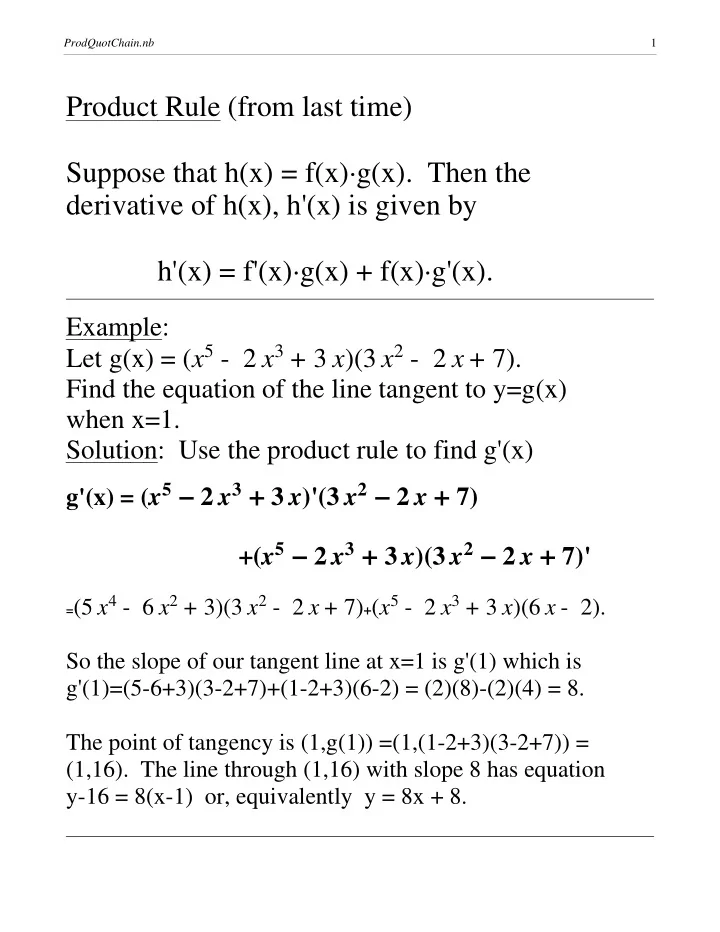

1 ProdQuotChain.nb Product Rule (from last time) Suppose that h(x) = f(x)·g(x). Then the derivative of h(x), h'(x) is given by h'(x) = f'(x)·g(x) + f(x)·g'(x). Example: Let g(x) = ( x 5 - 2 x 3 + 3 x )(3 x 2 - 2 x + 7). Find the equation of the line tangent to y=g(x) when x=1. Solution: Use the product rule to find g'(x) g'(x) = ( x 5 2 x 3 3 x )'(3 x 2 2 x 7) +( x 5 2 x 3 3 x )(3 x 2 2 x 7)' = (5 x 4 - 6 x 2 + 3)(3 x 2 - 2 x + 7) + ( x 5 - 2 x 3 + 3 x )(6 x - 2). So the slope of our tangent line at x=1 is g'(1) which is g'(1)=(5-6+3)(3-2+7)+(1-2+3)(6-2) = (2)(8)-(2)(4) = 8. The point of tangency is (1,g(1)) =(1,(1-2+3)(3-2+7)) = (1,16). The line through (1,16) with slope 8 has equation y-16 = 8(x-1) or, equivalently y = 8x + 8.
2 ProdQuotChain.nb Quotient Rule: Suppose that f(x) = p H x L q H x L . Then the derivative Ä Ä Ä Ä Ä Ä Ä Ä Ä Ä Ä Ä f'(x) = q H x L p ' H x L p H x L q ' H x L H q H x LL 2 . Find the derivative of f H x L = x 10 . x 7 Example: The number of bacteria, N(t), in a certain culture t minutes after a certain bactericide is introduced obeys the rule N(t) = 10,000 Ä Ä Ä Ä Ä Ä Ä Ä Ä Ä Ä Ä Ä Ä + 2000. 1+ t 2 Find the rate of change of the number of bacteria in the culture 1 minute and 2 minutes after the bactericide is introduced. What is the bacteria population at those instants?
3 ProdQuotChain.nb Solution: Use the quotient rule to find N'(t), and then find N'(1) and N'(2). N'(t) = H 1 t 2 L H 10000 L ' H 10000 L H 1 t 2 L ' H 1 t 2 L 2 = H 1 t 2 L H 0 L H 10000 L H 2 t L ' H 1 t 2 L 2 H 1 t 2 L 2 . 20000 t = This will provide the rate at which the size of the culture changes at any time t. 20000 H 1 L 20000 N'(1) = H 1 H 1 L 2 L 2 = = -5000 bacteria/min. 4 20000 H 2 L 40000 N'(2) = H 1 H 2 L 2 L 2 = = -1600 bact. / min. 25 After 1 minute, there are N(1) = 10000 1 1 2 +2000 = 7000 bacteria in the culture and the culture is los- ing bacteria at a rate of 5000 bacteria per minute. After 2 minutes the bacteria population is N(2) = 10000 1 2 2 +2000 = 4000, and the loss rate is 1600 bacteria per minute.
4 ProdQuotChain.nb Composing two functions, p(x) and q(x) in both orders. (p Î q)(x) = p(q(x)) and (q Î p)(x) = q(p(x)) è!!!!!!!!!!! Suppose that p H x L 3 and q H x L H x 7 L 2 . Then H p Î q L H x L p H q H x LL p HH x 7 L 2 L x "####################### # "########################### H x 7 L 2 x 2 3 14 x 52. H q Î p L H x L q H p H x LL But in the other order we have q Iè!!!!!!!!!!! Iè!!!!!!!!!!! 3 M 7 M 2 14 è!!!!!!!!!! ! x x 3 H x 3 L 14 è!!!!!!!!!! ! x 3 49 "########################### x x 3 52 . So H p Î q L H x L 14 è!!!!!!!!!! ! x 2 14 x 52 while H q Î p L H x L x x 3 52. Not equal.
5 ProdQuotChain.nb Chain Rule (for differentiating function compositions): If h(x) = (f Î g)(x) = f(g(x)), then the derivative, h'(x) = f'(g(x)) · g'(x). Examples in class!
Recommend
More recommend